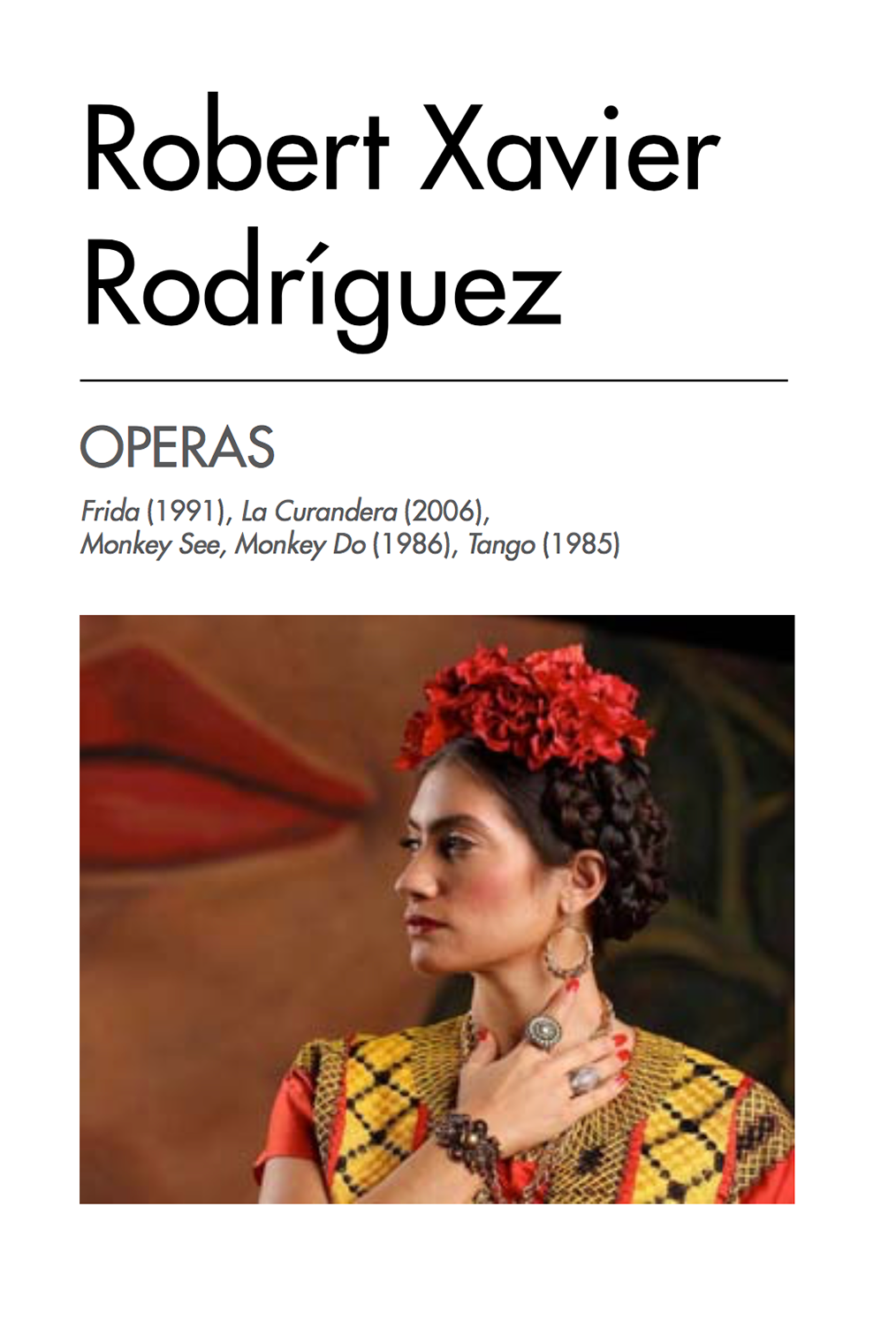- Robert Xavier Rodríguez
La Curandera (2006)
- G Schirmer Inc (World)
- cl(asx), tpt, btbn, 2perc, pf, acn, vn, vc
- Baritone, Bass, Contralto (Voice), Mezzo soprano, Soprano, Tenor
- 1 hr
- Mary Medrick
- English, Spanish
Programme Note
La Curandera (2005) is a comedy in one act, commissioned by Opera Colorado. The premiere production in 2006 was presented on a double bill with Mozart’s Bastien und Bastienne (1768). Mary Medrick's libretto of La Curandera is based on an original story inspired by Mozart’s three-character opera. The new Mexican setting replaces the original sorcerer with a curandera, or practitioner of folk healing and magic, and adds three additional characters. Although the libretto is primarily in English, there are frequent Spanish words and phrases, including many popular proverbs and idiomatic expressions from both Mexico and Spain. The libretto also incorporates actual curandera incantations, rituals and procedures from Mexican folklore as well as from current practice in Mexico and in the United States. In treating the natural and the supernatural as two sides of the same coin, the central character of the opera, La Curandera, embodies what conductor/composer Eduardo Mata described as an essential feature of his childhood in Mexico, “living close to witches and sorcerers. Their sons and daughters were my friends. I grew up in a world where magic and the interplay between the real and the objective and the unreal and the magic coexisted on a daily basis. This [syncretism] has been a way of life in many of the cultures of Hispano-America...”
The music of La Curandera, likewise, pays homage to Mozart, with a Mexican flavor. The six singers are joined by eight instrumentalists: clarinet (doubling alto saxophone), trumpet, bass trombone, percussion, accordion, piano, violin and cello. In the overture, the distinctive entrance music for Mozart’s sorcerer is heard, then transformed into sounds of mariachi. Authentic Mexican melodies are employed throughout the opera, including the national anthem, Mexicanos al grito de guerra, the traditional march, Zacatecas, the folk song, La chinita and several melodies, textures and harmonic patterns derived from the traditional son jarocho-style music of Veracruz: El guapo, Coni coni, El huerfanito, El borracho, El buscapies and La bruja. Arias, spoken dialogue and accompanied recitative alternate with intricate opera buffa ensembles in a score filled with Rodriguez' characteristic "richly lyrical" (Musical America) writing, in a style "romantically dramatic" (Washington Post) and full of the composer's "all-encompassing sense of humor" (Los Angeles Times).
Cast List:
GENERAL GOLFREDO DE LA BARCA: Bass
DIONISIA: Mezzo-soprano
RAMÓN: Baritone
LA CURANDERA: Contralto
ALBERTO: Tenor
ALBA: Soprano
Setting:
Present-day Tepoztlán, a village near Mexico City known for its curanderos/curanderas, or practitioners of folk magic.
The music of La Curandera, likewise, pays homage to Mozart, with a Mexican flavor. The six singers are joined by eight instrumentalists: clarinet (doubling alto saxophone), trumpet, bass trombone, percussion, accordion, piano, violin and cello. In the overture, the distinctive entrance music for Mozart’s sorcerer is heard, then transformed into sounds of mariachi. Authentic Mexican melodies are employed throughout the opera, including the national anthem, Mexicanos al grito de guerra, the traditional march, Zacatecas, the folk song, La chinita and several melodies, textures and harmonic patterns derived from the traditional son jarocho-style music of Veracruz: El guapo, Coni coni, El huerfanito, El borracho, El buscapies and La bruja. Arias, spoken dialogue and accompanied recitative alternate with intricate opera buffa ensembles in a score filled with Rodriguez' characteristic "richly lyrical" (Musical America) writing, in a style "romantically dramatic" (Washington Post) and full of the composer's "all-encompassing sense of humor" (Los Angeles Times).
Cast List:
GENERAL GOLFREDO DE LA BARCA: Bass
DIONISIA: Mezzo-soprano
RAMÓN: Baritone
LA CURANDERA: Contralto
ALBERTO: Tenor
ALBA: Soprano
Setting:
Present-day Tepoztlán, a village near Mexico City known for its curanderos/curanderas, or practitioners of folk magic.

 Located in the UK
Located in the UK
 Located in the USA
Located in the USA
 Located in Europe
Located in Europe
